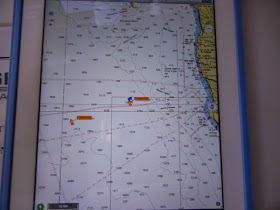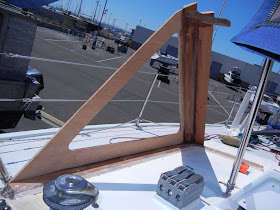Here we are passing under the Deception Pass bridge. The tide was against us that morning so I motored up Saratoga Pass.
We arrived the early morning of the 3rd in Neah Bay, where I tightened up the shrouds a bit more. Then we headed over and topped off with fuel and then headed out the inlet. The first way-point was the #2 buoy off of Cape Flattery. After that I set a way point past the coastal shelf.
In the morning of the 4th (4:30 am) we had travelled 160 miles, and we were straight out from Cape Johnson (N 47º 57'). It was still a bit cold even during the day.
By the morning of the 5th we had passed by the Columbia River inlet. At that point we were about 50 miles off shore The farthest during the whole passage.
The morning of the 6th we were off of the Umpqua River. That night is when we got hit by gusting winds a rough seas.
The morning of the 7th we pulled into Crescent City (The City of flies) for some R&R and reorganize, then to find a weather low building even more so off the coast.
We call it the City of flies b/c the first afternoon some kelp flies showed up for a BBQ and went away at dusk. The next morning they called in the whole family before we could pull out. We must have killed 100 flies between Crescent City and SF. They wouldn't leave the boat. We must have been the fresh meat in town.
That morning of the 8th we snuck out in the fog to out run the weather low, which was building and heading north. We made a good decision. We hugged the coast until Cape Mendocino and then headed out around the point that evening.
During the 9th we sailed on a reefed Genny thru the night to half way between Cape Mendocino and Pt. Arena then hit dead air about mid day, so motored that day and thru the night, which turned into a light fog the rest of the night. During that day I got a video of a family of white sided porpoise playing along side the boat as it motored along.
The morning of the 10th the wind picked up. So we hoisted the sails and started the last leg for SF it was about 4 hours away by calculations. But as time passed the wind begin to build. After two hours were were in 26 kt winds and hauling ass on a close reach. When we reached the entrance buoys we turned before the wind and headed for the Gate. And just as we passed under the gate we came head to head with the Oracle which was starting its turn to head back SE. We rolled up the Genny and sailed by the main alone since it was straight down wind, then sailed under the Bay bridge and on into Alameda. And here she sits.
The boat and equipment did really well except the Garmin 6208 plotter. The thing wouldn't boot up after we left C. City. Just colored lines down the screen. The first day I started up the new Spectra 150 water maker. The boat was able to maintain power between motor runs, which was due to lack of wind, mostly in the mornings.
In the end the boat had lost a piece of rigging for the lazy jacks, a mast mounted deck light came loose and fell overboard, the RAM mic from the VHF drowned hanging over the side in the middle of the night, wore a hole in the Bimini and blew out the flag on the MOB pole from the 45 kt winds we hit off the southern coast of Oregon. Oh, and I lost the screw out of my glasses twice, which I didn't find the second time. Had to wire them together until I got home.
The AIS kept us out of trouble running out the Sound at night. Twice we got bumped by our CPA. The big boys don't want us heading in their direction. But I also discovered the AIS can be out of sync too. I had one boat call me and said he was going to cross my path head on. When I check my readings he's was 30 miles behind me pulling into Pt. Angeles.
Checking back on the weather, It seems we got out of Seattle just in time. After we left a rain storm hit the Puget Sound area and flood warnings were in effect. At that time we had just pulled into Crescent City and caught the weather report history. Funny thing is we left two other boats in Neah Bay who were going to leave south the day after us. They had been waiting out the weather. I wonder what they decided to do? And I heard it was still raining with thunder and lighting. Not something I would want to be in while out in the open Pacific!
Fortunately, it only took 10 days via Roche Harbor, Neah Bay and Crescent City. That's an average of 97 kt miles per day. A good run I would say. And the good part is we never got into any rain. The wettest part of the trip was pulling out of the fog and going past the Farallon Islands.
Fortunately, it only took 10 days via Roche Harbor, Neah Bay and Crescent City. That's an average of 97 kt miles per day. A good run I would say. And the good part is we never got into any rain. The wettest part of the trip was pulling out of the fog and going past the Farallon Islands.
Well, That's it. I flew home on 9/17/13, after putting the boat in a floating storage state. IAW stow away loose gear and flush out the saltwater systems, pickle the water makers and do some minor repairs too.
Most of these pictures were taken by Mark O. one of my crew members. Thanks Mark!
The entrance to SF bay....................
Watching the AIS at night.............
After arriving in Alameda, a record of the total miles. And the max speed, probably done on the last run into SF.
And here is a record of the passage...............












.JPG)



















































